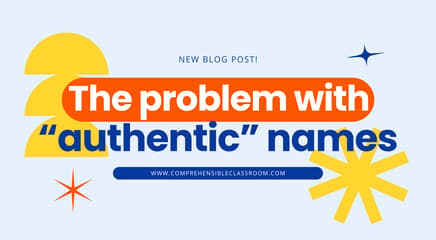It’s summertime! You’ve wrapped up your last few weeks of school, and you are on your way to the fun summer activities you’ve been dreaming about since February. If those activities include nap as much as possible, well, we’re in full support.
Summer is also a great time for personal goals, especially our own L2 journey. During the school year, maintaining and growing our own language proficiency can easily take a back seat to the day to day needs of classroom teaching. However, maintaining a high level of proficiency in the language we teach is important.
When we are confident communicators in the language of instruction, we can more confidently lead classes in the target language and modify communication to our students’ levels. For teachers who teach their native language, maintaining proficiency in a new or additional language is an important way to stay connected to our students’ own acquisition journeys.
How can language teachers improve their proficiency?
No surprise here – what your students need is also what you need: comprehensible input! Communicatively-embedded comprehensible input, that is.
Comprehensible Input is often misunderstood as super simple language that is “dumbed down” for beginners. This is SO not the case! Comprehensible Input is not one particular kind of language. What constitutes Comprehensible Input is subjective, and it depends on the individual engaging with it.
The input that is comprehensible for beginning students is very constrained: a small vocabulary range, simple and direct constructions, short utterances. The input that is comprehensible to YOU may be linguistically complex, standard/native-like input. Or, perhaps your Comprehensible Input looks more like the language found in a Young Adult (YA) novel: standard input, but not a super high reading level.
It all depends on your level of proficiency.
The key when looking for ways to maintain or improve your proficiency is finding input that’s level-appropriate for you.
Look for sources of input that you can understand but that also feel like they are stretching you just a bit – maybe because they contain some new words or the input is about an unfamiliar topic, maybe because the rate of speech is fast, maybe because it covers a lot of timeframes and moods.
You’re looking for input that fits Krashen’s mysterious “i + 1” for you, for where you’re at right now.
Where to find comprehensible input
Here are some places that you might find language-teacher-level Comprehensible Input if you’d like to make boosting your language skills a goal for this summer. Look for something that’s enjoyable and easy enough for you to understand that it doesn’t just become noise.
Want to keep track of your progress? Download our L2 summer bingo game here!

Watch TV shows or movies
Here are two options for watching TV shows or movies that you will likely be able to understand.
Closed Captioning on content you’re already familiar with
When you’re already familiar with the plot, characters, and dialog, it’s easier for your brain to link the incoming forms to meaning. Instead of trying to figure out what's going on, like whether Ana is secretly the killer or if the heroes missed their time-travel window, you’re just listening to them describe it in a different language.
Subtitles often don’t match the dialog of a movie exactly, as they’re meant to convey a general essence as it relates to the story instead of the exact translation of the words.
Instead, put on closed captioning so you have an exact transcription. This still gives you the benefit of subtitles (listening and reading input) without sacrificing meaning.
Extra credit: Find a podcast, blog post, or review in the target language about the movie or TV show. See how much you can understand, or check it against what you picked up on while watching the content.
Put subtitles on in your L1/English on new-to-you content
Listen to me: putting subtitles on in your original language while watching new-to-you content in your target language is NOT “cheating,” “slacking,” or in any way negative.
If there’s a voice in your head saying that – get outta here, meanie!
Remember, the point of watching something to improve your language skills isn’t for you to just stare at the pretty pictures on screen while language floats by. You have to understand the meaning in context.
Since we’re not actively pausing to ask ourselves comprehensible questions or breaking the movie up to ClipChat ourselves, putting on subtitles is a way that you can check your comprehension and even establish meaning for something you’re not sure of.
“What was that word?” Pause, check the L1/English subtitle, and then move on. Just keep in mind, subtitles are often written by someone different than who wrote the original script.
Depending on your level, you could put on subtitles or closed captioning in the target language. Just make sure that you:
- Understand what’s going on in the story
- Pause when you hear a word you don’t understand
- Notice when your brain starts to focus on other things besides the language in context and the plot (“Huh, look at what that extra is doing in the background. They’re very animated. Really overdoing it. Why are they wearing that?”). That’s a sign that the language was too complex, and you tuned out!
Extra credit: Try out a language-extension like Language Reactor and see how it helps with processing and acquisition.
Ideas for TV shows in Spanish:
Here are some TV shows for Spanish teachers looking for input!
- El Ministerio del Tiempo (sci-fi)
- Cable Girls (drama)
- Money Heist (drama)
- Club de Cuervos (comedy)
- La Casa de las Flores (dramedy)
- Control Z (teen drama, Gossip Girl vibes)
- Vis a Vis (drama, similar to “Orange is the New Black”)
- Las Bravas F.C. (If you loved "Bend It Like Beckham," don’t miss this Mexican show about a local women’s soccer team)

Listen to podcasts
Want to acquire language through aural input? Try a podcast!
If you’re doing something else while listening that requires some attention (driving, making lunch for children high off summer vacation vibes, etc), make sure the language is well within your acquisition-comfort zone. The more your attention is divided, the easier it should be to understand the input.
If you’re doing something mindless (cleaning, walking, pulling weeds from the garden, etc), you can challenge yourself a little more with podcasts on denser topics, faster rates of speech, containing casual language with slang, etc.
Ideas for podcasts in Spanish:
- Garbanzo Spanish Podcast - the team at Garbanzo specifically created this podcast for beginning Spanish learners with a focus on comprehensible-input, so much of the work is already done for you! The first season is for beginners, and our second season features legends. The second season might be a good fit for language teachers that are intimidated by the idea of listening to native-like content!
- Radio Ambulante: narrative podcast featuring Latin-American stories
- No Hay Tos: a Mexican podcast from two childhood best friends, who cover a range of topics
- La Tortulia podcast: While this podcast ended last year, you’ve still got at least 200 episodes to go through and listen in as two friends cover lesser-known historical stories
- El gran apagón: This fiction podcast covers a solar apocalypse that no one saw coming… or did they?
- Fallo de Sistema: Spanish podcast that covers ALL THINGS GEEK: science fiction, video games, and science in general
- Así como suena: stories from Mexico, with a focus on Mexico City
- Nómadas: Travel-focused podcast
- Sangre sobre la tierra: Love all things horror and creepy? This is the podcast for you
- Nadie sabie nada: Two comedians answer questions and and riff off comments sent in

Read books
There are SO many resources for great books. Start with your local library, and see what’s available in your target language. As with any content, you’ll want to pause after you read a section to self-evaluate whether it feels too easy, too difficult, or just right.
If the book is your own, you could consider doing some annotations as you read to make sure you’re focusing and what you’re reading and not letting the words fly by without, y’know, actually processing them.
Read books you’re already familiar with
As we mentioned with the movies and tv shows above, consider reading content in your target language that you’re already familiar with. These could be novels you’ve read repeatedly in your native language that have been translated into your L2, or books with book-to-movie adaptations where you’ve seen the movie.
Read books you’re NOT familiar with - at a slightly lower level
When we’re reading unfamiliar books in the target language, consider starting with books that are written at a level that’s slightly lower than where you think you’re at. As you read, check in with yourself and your comprehension. Are you being slightly stretched, or is it too easy?
Ideas for books in Spanish:
Beginner - intermediate:
- Manolito Gafotas by Elvira Lindo
- Tajín y los siete truenos by Felipe Garrido
- Piratas del Caribe y el mapa secreto, by Mira Canion
- Cuando florecen los almendros by Elina Ramírez
Young Adult (primarily fantasy)
- Las memorias del Águila y el Jaguar by Isabel Allende
- Todas las hadas del reino by Laura Gallego (fantasy)
- La ciudad de las bestias by Isabel Allende (fantasy)
- Grimpow trilogy by Rafael Ábalos (fantasy)
- La Guerra de las Brujas by Maite Carranza (fantasy)
- No pidas sardina fuera de temporada by Andreu Martín and Jaume Ribera (detective novels)
Where to find books
- Your local library system!
- Libby
- TPRS Bookshop
- Amazon – sometimes it’s tough to find specific titles at local bookstores and/or the library
- Publishers (for example, Penguin Random House has a New Releases: Spanish Language Fiction section)
Learn more about language acquisition
So you’ve got your library books on hold, your podcasts queued up, and your target language movie watch party ready to go with your language teacher friends but you don’t quite remember all the specifics of the theories behind CI and acquisition-driven instruction?
Don’t worry, we’ve got you covered here too! Here are a few books we recommend:
Books by Dr. Bill Van Patten:
- While We’re On The Topic
- Language Acquisition in A Nutshell
- The Nature of Language
Others:
- The Power of Reading by Stephen Krashen
- TPRS with Chinese Characteristics by Dr. Terry Waltz
- Common Ground by Dr. Florencia Henshaw and Maris Hawkins




